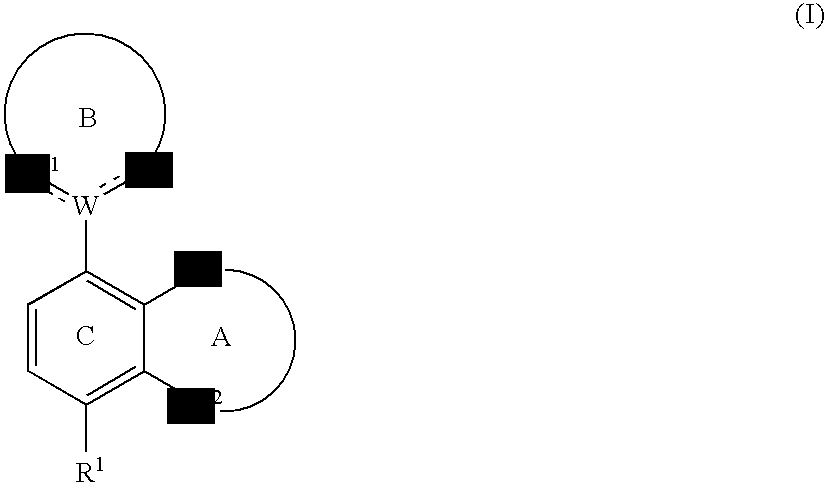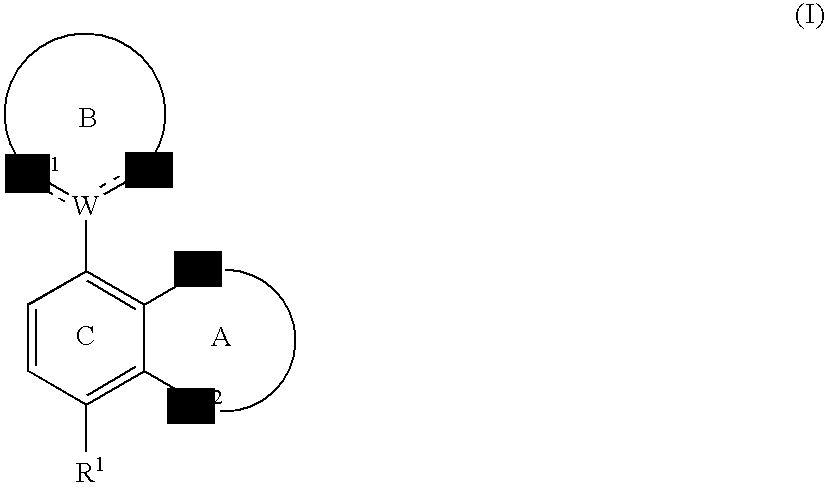Fused benzene derivative and use
a technology of condensed benzene and derivatives, applied in the field of condensed benzene derivatives, can solve the problems of causing a great burden on the liver
- Summary
- Abstract
- Description
- Claims
- Application Information
AI Technical Summary
Benefits of technology
Problems solved by technology
Method used
Image
Examples
reference example 1
[0437]To a mixture of copper sulfate (11.4 g) and water (80 ml) was added sodium iodide (13.9 g) at room temperature, and the mixture was stirred at 0° C. for 10 minutes. Sulfuric acid (3.0 ml) and nitric acid (3.0 ml) were added thereto, and after 5 minutes, 4-nitro-1-naphthylamine (5.00 g) was added thereto. After 5 minutes, a mixture of sodium nitrite (2.57 g) and water (5.0 ml) was added thereto at 0° C. for 1 hour. The mixture was extracted with ethyl acetate, and the extracts were washed with sodium thiosulfate solution and brine, dried, and concentrated. The obtained residue was purified by silica gel column chromatography to give 1-iodo-4-nitronaphthalene (1.70 g).
[0438]1H-NMR (300 MHz, CDCl3) δ: 7.69-7.80 (2H, m), 7.87 (1H, d, J=8.1 Hz), 8.22 (1H, d, J=8.1 Hz), 8.25-8.28 (1H, m), 8.46-8.49 (1H, m).
reference example 2
[0439]A mixture of 1-iodo-4-nitronaphthalene (1.70 g), sodium trifluoroacetate (3.07 g), copper iodide (I) (2.10 g) and 1-methyl-2-pyrrolidone (40 ml) was stirred at 160° C. for 5 hours under argon atmosphere. After cooling to room temperature, brine and ethyl acetate were added thereto, and the insolubles were filtered off using celite. The mother liquor was distributed, and the organic layer was washed with brine, dried, and concentrated. The obtained residue was purified by silica gel column chromatography to give 1-nitro-4-(trifluoromethyl)naphthalene (897 mg).
[0440]1H-NMR (300 MHz, CDCl3) δ: 7.74-7.83 (2H, m), 7.96 (1H, d, J=7.8 z), 8.09 (1H, d, J=7.8 Hz), 8.28-8.32 (1H, m), 8.39-8.45 (1H, m).
reference example 3
[0441]A mixture of 1-nitro-4-(trifluoromethyl)naphthalene (813 mg), 10% palladium carbon (50% water content, 717 mg), methanol (16 ml) was stirred at room temperature for 1.5 hours under hydrogen atmosphere. The palladium carbon was filtered off using celite. The mother liquor was concentrated and the obtained residue was purified by silica gel column chromatography to give 4-(trifluoromethyl)-1-naphthylamine (634 mg).
[0442]1H-NMR (300 MHz, CDCl3) δ: 4.46 (2H, br.s), 6.71 (1H, d, J=8.1 Hz), 7.49-7.62 (2H, m), 7.66 (1H, d, J=8.1 Hz), 7.82-7.85 (1H, m), 8.12-8.16 (1H, m).
PUM
| Property | Measurement | Unit |
|---|---|---|
| temperature | aaaaa | aaaaa |
| temperature | aaaaa | aaaaa |
| body weight | aaaaa | aaaaa |
Abstract
Description
Claims
Application Information
 Login to View More
Login to View More - R&D
- Intellectual Property
- Life Sciences
- Materials
- Tech Scout
- Unparalleled Data Quality
- Higher Quality Content
- 60% Fewer Hallucinations
Browse by: Latest US Patents, China's latest patents, Technical Efficacy Thesaurus, Application Domain, Technology Topic, Popular Technical Reports.
© 2025 PatSnap. All rights reserved.Legal|Privacy policy|Modern Slavery Act Transparency Statement|Sitemap|About US| Contact US: help@patsnap.com



